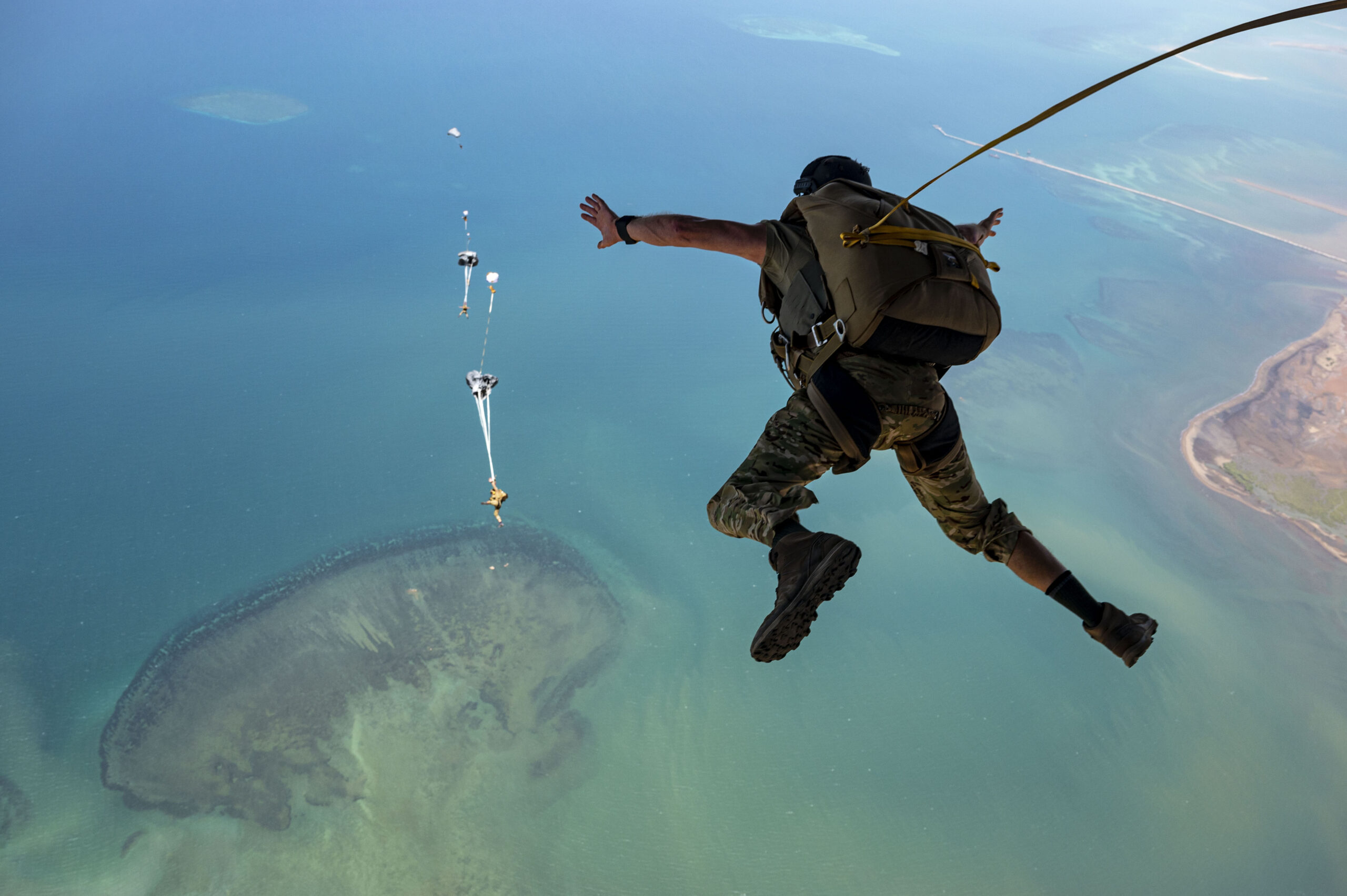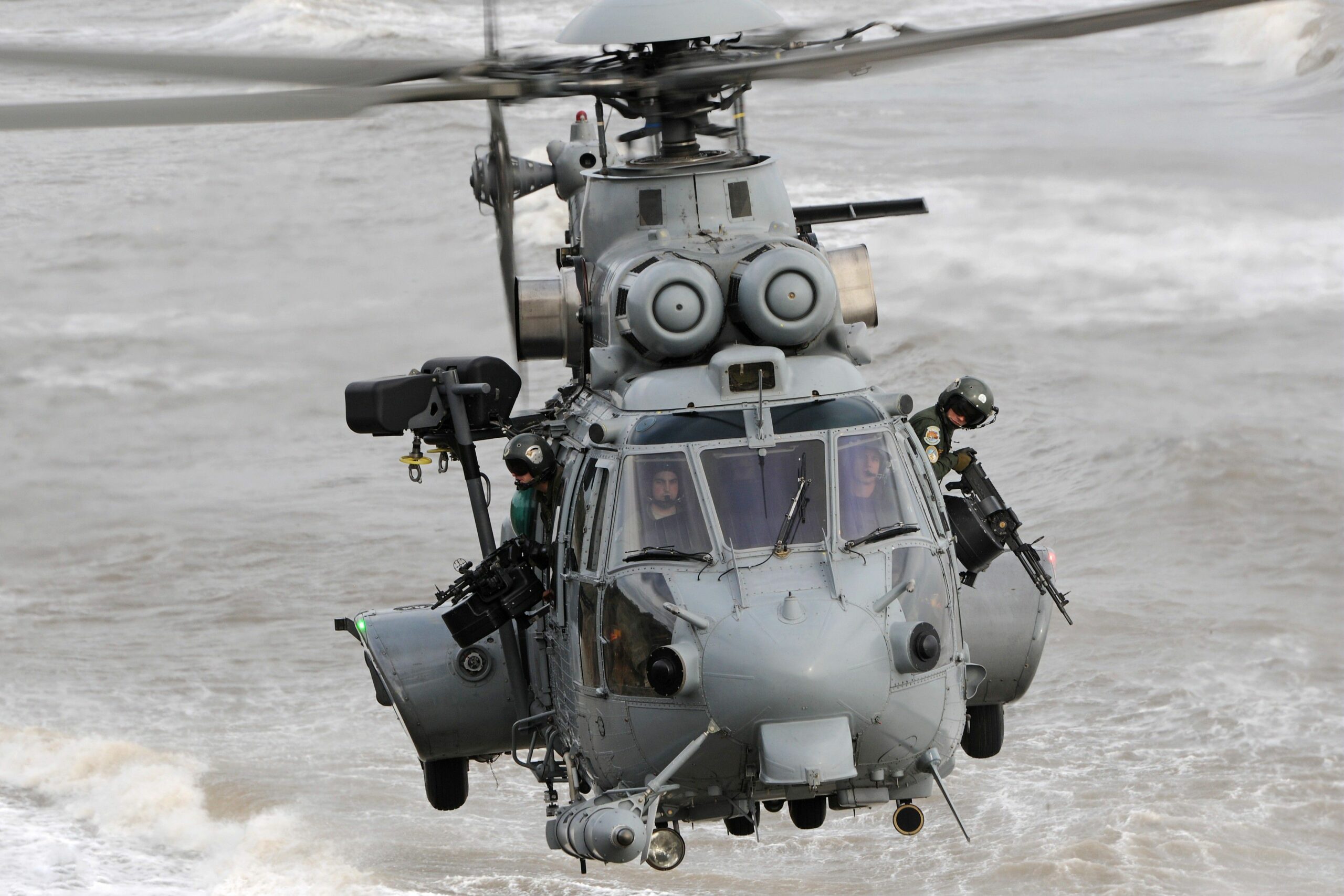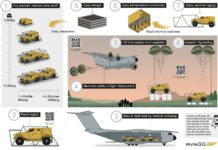Armed forces must reexamine their combat search and rescue (CSAR) capabilities in light of operational realities associated with the return to great power competition and peer-warfare.
The acronym CSAR can stand for Combat Search and Rescue or Combat Search and Recovery. While CSAR is dedicated to finding and retrieving any military personnel who are cut off or in danger in a conflict zone (including at sea), these missions most frequently seek to recover downed aircrews, usually in hostile or conflicted territory. Personnel recovery missions often go far beyond deployment of a single CSAR helicopter. Depending on the operational environment – and especially the threat level – they can be highly complex and involve dozens of aircraft and potentially ground units. One of the largest CSAR missions of the Vietnam War, the rescue of the Callsign Boxer 22 aircrew, occurred in December 1969 and lasted three days. It involved 336 sorties, mostly by combat aircraft suppressing enemy air defence positions and North Vietnamese Army (NVA) ground forces who were hunting the American pilots. More than 1,400 bombs and rocket pods were expended. Five of ten CSAR helicopters involved in the mission incurred so much damage that they had to be retired.

Credit: USAF/Staff Sgt. Aaron Irvin
During the half century following that mission, highly sophisticated air defence systems have been developed, which can hold CSAR aircraft at risk potentially even hundreds of kilometres ahead of their destination. The special aspects of CSAR lead to specific attributes required of CSAR platforms. These include: long range and endurance; preferably aerial refuelling capability; sufficient size to accommodate a ground-search party and/or to recover several servicemembers in one mission; robust and redundant navigation systems; multiple sensors including radar and optoelectronic sights to detect and identify both hostile and friendly forces; passive and active self-defence capabilities including electronic countermeasures and jamming, chaff and flares, as well as armaments for self-defence; broad spectrum communications systems capable of receiving situational awareness updates in real-time, while also interfacing with survival radios carried by the downed pilots. Speed and manoeuvrability are paramount, especially during the actual personnel retrieval phase of the mission.
CSAR Helicopters
Since the Korean War, helicopters have been the primary CSAR platform. Very few armed forces can afford to operate aircraft dedicated solely to personnel recovery. The majority conduct CSAR with aircraft which are optimised for a limited number of additional complex missions such as special operations forces (SOF) support and transportation, and casualty/medical evacuation (CASEVAC/MEDEVAC).
HH-60W Jolly Green II
The United States is a notable exception here. While the other US service branches deploy multi-mission helicopters for combat and non-combat personnel recovery, the US Air Force (USAF) operates dedicated CSAR helicopters; personnel recovery is officially one of the twelve core functions of the USAF. The HH-60G Pave Hawk entered service with USAF in 1982. It is now being replaced by the HH-60W Jolly Green II under a 2014 contract award to Sikorsky, with the HH-60W having achieved Initial Operating Capability (IOC) in 2022. USAF originally planned to acquire 113 of the new helicopters, but this was cut to only 75 in the Fiscal Year 2023 defence budget; Congress added back an additional 10 aircraft into the 2023 budget, for a total procurement of 85 units. They are due to be permanently based in Italy, Japan, and various domestic locations.

Credit: USAF/Staff Sgt. Enrique Barcelo
The HH-60W is based on the UH-60M Black Hawk variant, which introduced the digital or ‘glass’ cockpit which integrates all tactically relevant information, from aircraft diagnostics to moving maps, on one set of displays. Communications systems include wideband-UHF and narrow-band satellite communications (SATCOM), Link 16, Video Data Link (VDL), Situational Awareness Data Link (SADL) and Automatic Dependent Surveillance – Broadcast (ADS-B). The Flight Director navigation tool includes an improved autopilot which allows the crew to automate certain flight manoeuvres such as hovering, move in a specific direction, or initiating a go-around, freeing the pilots to deal with other high-priority tasks during critical phases of the mission. Other enhancements over the HH-60G include improved hot weather/high altitude performance, an enlarged cabin capable of accommodating more personnel, and double the internal fuel capacity.
The new helicopter achieves a top speed of 280 km/h (151 kn) and a range of 1,100 km, which can be extended through aerial refuelling. Armament options consist of either two 7.62 mm gatling guns or two 12.7 mm (.50 cal) machine guns, with either option mounted externally. Force protection attributes are geared to defeating sophisticated threats and include: a digital radar warning receiver (RWR); the Distributed Aperture Infrared Countermeasure System (DAIRCM) which provides missile-, laser-, and hostile fire alerts and automatically triggers countermeasures; the Degraded Visual Environment Pilotage System (DVEPS) which helps pilots fly through dense dust, sand, snow and fog; as well as cockpit and cabin armouring to provide a degree of protection from small arms fire.

Credit: USAF/Master Sgt. Tristan McIntire
The HH-60W performed its first real-world recovery mission in January 2023, rescuing two wounded soldiers from a battlefield in the Horn of Africa. The recovered personnel were medically stabilised in flight by pararescue specialists. Neither the nationality of the wounded nor the precise location of the operation was released. The helicopter was on rotational assignment to the Combined Joint Task Force – Horn of Africa (CJTF – HOA), headquartered in Djibouti.
H225M Caracal
While the HH-60W is a specialised CSAR helicopter which can be used for additional high-end missions as needed, the H225M Caracal is a multi-mission aircraft optimised for SOF support and related missions including CSAR. The Caracal is the newest member of the Airbus Super Puma/Cougar family. It entered service with the French Air Force in 2005 as a CSAR system, and is currently operated by nine countries for various missions, and in June 2023 the Royal Netherlands Air Force announced that it would also acquire 14 units.
The all-weather, all-climate-capable aircraft has been deployed in Afghanistan, Lebanon, and various African theatres. It can operate from land or from ships. For CSAR missions the unrefuelled tactical radius of action is 370.4 km (200 NM), which can be extended through aerial refuelling. According to Airbus, the aircraft has a 95% readiness rate and can deploy within five minutes of an alert. The airframe is optimised for survivability, enhancing the odds of reaching and extracting the endangered personnel. Survivability aspects include: a reinforced structural frame; energy-absorbing landing gear; self-sealing crashworthy fuel tanks; armoured and energy-absorbing crew seats; armour plated fuselage sides and flooring; infrared shielding of the exhaust system; and a small arms fire resistant rotor system.

Credit: Airbus
Improvements over the previous Super Puma/Cougar aircraft include a low-vibration five-blade main rotor system and a reinforced gearbox. The glass cockpit features four 25×20 cm displays with full navigational and flight control data as well as collision and targeting alerts. The four-axis dual-duplex autopilot ensures flight stability and automatically adjusts performance when one of the two engines is inoperable. Additionally, it manages flight patterns and can automatically transition the helicopter to a hover when the target is acquired, ensuring the fastest possible transition to extraction mode. Fast rope beams and a double hoist with a sling capacity of 4.75 tonnes facilitate swift egress of rescue specialists and extraction of injured or ambulatory personnel. The cabin can accommodate up to 28 passengers, enabling recovery of platoon-sized groups, naval crews, or responding to downed aircraft carrying a larger crew or paratroopers. Alternately the cabin can fit 11 litters plus four pararescue specialists. The helicopter evacuates the pickup zone with a 3.6m/s climb rate and a maximum airspeed of 315.8 km/h (170 kn), or at a fast cruising speed of 227.8 km/h (150 kn).
Fixed Wing Aircraft
Fixed-wing aircraft can also be deployed for CSAR missions, often augmenting and supporting helicopters. Advantages of fixed-wing aircraft include greater airspeed, a higher potential service ceiling which permits surveillance of larger swathes of territory, a larger airframe capable of mounting additional sensors and weapons for suppressing ground fire, and the ability to take a larger number of people and more equipment on board. The latter includes pararescue specialists as well as all-terrain vehicles. Tactical aircraft can land in clearings or roads to deploy search personnel who can proceed on foot or by vehicle into difficult or defended terrain to locate and extract their targets. Alternately, search and rescue personnel and vehicles can be airdropped.
HC-130J Combat King II
The USAF’s dedicated fixed-wing CSAR aircraft are designated the HC-130J Combat King II. Introduced in 2013, the 39-unit HC-130J fleet replaced the Vietnam-era HC-130N/P Combat King. A standard crew consists of two pilots, a combat systems officer (CSO), two loadmasters, and a three- or four-person rescue team. Performance parameters include an 8,334 km (4,500 NM) range, which is extendable via refuelling, a 10,000 m (32,808 ft) service ceiling, and a 583.4 km/h (315 kn) airspeed at sea level. In practice, the aircraft fly at medium to low altitudes over land and water to minimise risk of detection. When possible, flight operations are conducted at night under blackout conditions and communications silence. In addition to inserting pararescue teams and airdropping survival kits to cut-off personnel, the HC-130J refuels American and allied/partner CSAR helicopters in flight via underwing pods, or lands to establish a forward area refuelling point.

Credit: USAF/Senior Master Sgt Ralph Branson
The new aircraft features numerous technology upgrades including an improved refuelling receptacle, optoelectronic day/IR cameras, dual SATCOM, integrated inertial navigation system (INS) and GPS navigation, as well as night vision goggle (NVG) compatible lighting. The integrated situational awareness and force protection suite is configured to provide the aircraft with a modern self-defence capability. Key elements include the Block 8.1 avionics suite; the Lightweight Airborne Radio System (LARS) which incorporates the new 406 MHz distress frequency, and promises to facilitate location of missing aircraft, vessels, and personnel; the Situational Awareness Capabilities Upgrade (SACU), which includes a Link 16 datalink, blue force tracking, advanced mission planning, and enhanced displays; as well as the Northrop Grumman Advanced Threat Warning (ATW) system which includes missile warning capability, hostile fire indication, laser warning, and situational awareness; radio frequency countermeasures (RFCM); and integrated flare and chaff launchers.
Changing Operational Environment
Despite the advances in operational systems and force protection technology, even the latest CSAR platforms may prove inadequate in future war scenarios. Advanced air defence radars, long range missiles, and sophisticated manned and unmanned aircraft threaten to down rescue helicopters well before they reach the pickup zone. Another perceived challenge is the fact that great power conflicts are expected to involve offensive operations at much greater distances than recent conflicts in the greater Middle East and Afghanistan.
Retrieving aircrews lost on such deep penetration missions could strain or exceed the operational range of current helicopters. In the Indo-Pacific theatre, the odds of aircraft being shot down over the sea increase significantly, which brings additional challenges – including a shorter window of opportunity – to the CSAR mission.

Credit: USAF/Staff Sgt. Devin Boyer
The Pentagon, in particular, is currently re-evaluating its CSAR force structure in light of the evolving threat picture and operational environment. This reassessment is behind the USAF’s decision to truncate HH-60W procurement, said US Air Force Secretary Frank Kendall. “When we were doing counterinsurgencies, and we were losing pilots in those kinds of situations, the needs were different. The acts of aggression like we’re seeing in Europe, or we might see in the Pacific […] put us in a very different scenario,” Kendall told reporters in March 2023. Lieutenant General Jim Slife, Air Force deputy chief of staff for operations, echoed this sentiment during an April 2023 Senate testimony. “The challenge we are facing is really how to address the question of how will we do personnel recovery in a contested environment. We are actively looking at nontraditional ways in order to fulfil that moral imperative of leaving nobody behind. But until we can come to a definitive answer on that, I think the one thing we can say is that helicopters […] that fly 115 knots refuelled by C-130s with pararescuemen that ride a hoist up and down is probably not the answer in our most stressing scenarios.”
Looking to Unmanned Systems
One proposed solution to overcoming hostile defences is to employ swarms of unmanned CSAR aircraft. Electric Vertical Take-Off and Landing (eVTOL) aircraft based on modern air taxi concepts could land, pick up several servicemembers, and return to safety, while manned or unmanned combat aircraft provide cover. The UAVs could be simultaneously deployed from numerous angles and cover a broad search area or simply provide redundancy, ensuring sufficient aircraft are able to reach the pickup zone. One major challenge will be extending the operational range, battery endurance and airspeed of eVTOL aircraft to enable deep penetration of the conflict zone. An alternate proposal would be deploying unmanned variants of high-performance helicopters such as those competing for the US Army’s Future Vertical Lift (FVL) programme.

Credit: Joby Aviation
Over time, technology is likely to mitigate issues such as range, speed and mission autonomy limitations, thereby improving unmanned VTOL systems’ ability to penetrate contested airspace. However, there remains the fact that wounded personnel may be unable to enter a UAV and secure themselves without human assistance. This would imply that unmanned aircraft would best serve as reconnaissance assets and as decoys to assist a single manned aircraft – either an advanced helicopter or tiltrotor outfitted with high-performance sensors, electronic countermeasures and survival suites – in performing the actual recovery. In practical terms, such solutions are probably still a decade away.
Sidney E. Dean




![Transport aircraft trends: A market overview The Xi’an Aircraft Industrial Corporation (XAC) Y-20 entered service with the Chinese military in 2016; the aircraft can be considered the Chinese equivalent of the Boeing C-17. A tanker variant is available, while the Y-20 also provides the basis for the new KJ-3000 AEW&C platform. [Cute Orca Weibo Account]](https://euro-sd.com/wp-content/uploads/2025/06/Y-20-China-Kopie-218x150.jpg)


